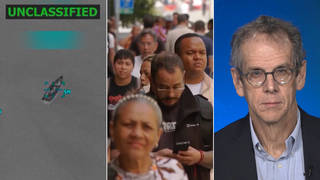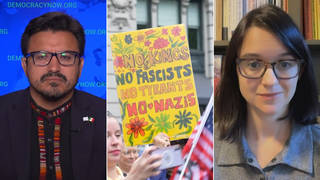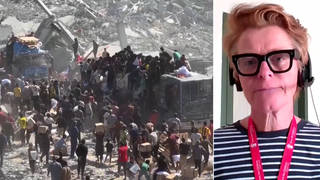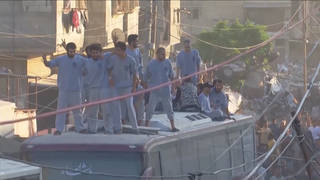
Guests
- Katherine Newmanprofessor of sociology and public affairs at Princeton University. She has previously taught at Columbia, Berkeley and Harvard, where she founded the doctoral program in sociology and social policy. She is the author of several books, including Rampage: The Social Roots of School Shootings (Basic Books).
Virginia has carried out the first change in policy to result from the deadly shooting of 32 people at Virginia Tech more than three weeks ago. Virginia Governor Timothy Kaine has issued an executive order requiring anyone forced to seek treatment for mental health to be added to a police database of people barred from buying guns. We talk to Princeton professor Katherine Newman. [includes rush transcript]
Transcript
AMY GOODMAN: Virginia has carried out the first change in policy to result from the deadly shooting of 32 people at Virginia Tech more than three weeks ago. On Monday, Virginia Governor Timothy Kaine issued an executive order requiring anyone forced to seek treatment for mental health to be added to a police database of people barred from buying guns.
The order comes amidst the news state judicial and mental health officials failed to follow up on a ruling ordering Cho to get mental health treatment. The Washington Post reported a judge had found Cho “mentally ill and in need of hospitalization” in December of 2005, but no action was taken to ensure Cho received the ordered care.
My first guest is a professor of sociology and public affairs at Princeton University. Katherine Newman is also the lead author of a landmark study published as the book Rampage: The Social Roots of School Shootings. Katherine Newman joins us now in the firehouse studio. Welcome to Democracy Now!
KATHERINE NEWMAN: Thank you, Amy.
AMY GOODMAN: Talk about your thoughts right after the shooting took place?
KATHERINE NEWMAN: Well, it was a very familiar story for me, I’m sorry to say, because having studied all of the school shootings that have occurred since 1970, the pattern in Cho’s case was not really remarkably different, with the possible exception that it occurred in a university setting, which is very rare. Really, we have to go back to about 1966 in the Texas sniper case to find an incident of this kind on a university campus. But we have seen a spate of school shootings in high schools across the country, and the elements of this shooting were very similar.
AMY GOODMAN: Go through what you now understand as the day that all of this took place three weeks ago and the evidence that you see as the stories come out on what was understood about Cho Seung-Hui.
KATHERINE NEWMAN: I think there’s still many elements of what happened on that day that we are not entirely sure about, but it appears as though he got up very early in the morning, that he ended up shooting two people. His relationship to those two people is still unclear, but it does appear that he had some acquaintance with at least the girl that he shot. Then he went back to his room and assembled materials that he had been working on for some time, including the video materials that portrayed a portrait of himself he wanted to leave us with, which was very different from the self he actually represented in his daily life, and he went out and mailed those materials to one of our major news studios, came back, got his weapons together, went to the classroom building, which he barricaded, and then went methodically through classrooms shooting people with weapons that would allow him to shoot many at the same time. And he shot himself finally when he realized the police were on the way.
AMY GOODMAN: I think what has shocked so many people, among many other shocks, is that after he killed the first young man and woman in the dorm, that the university put out no warning and actually said they didn’t think the shooter was a threat after that. They didn’t even know where he was.
KATHERINE NEWMAN: There are many unanswered questions that are going to be investigated on that campus, I’m sure. And I will say that most universities lack the capacity for an automatic and immediate warning of all of their students and faculty. The same thing could have happened on my own campus, because it’s not easy to contact students and faculty who are disbursed over so many buildings, so many places, off campus, on campus. I’m not excusing what happened there. I think they’re going to take a very serious look, but apparently the police thought this was an incident that occurred in the dorm and the shooter had left the area. But obviously they should have secured the campus. I’m sure they wish they had.
AMY GOODMAN: And talk about the information we now have on how the university, how individual professors, particularly the English department, the chair of the English department, professors like Nikki Giovanni, the well-known poet and writer, had been seeking help for this young man for quite some time, had understood from the plays that he had written how violent he was, the turmoil inside.
KATHERINE NEWMAN: The most tragic thing about the Virginia Tech case is that Cho was on everyone’s radar screen. That is actually quite unusual. And the faculty was very proactive in seeking help for him, in trying to shield other students from his aberrant, violent tendencies. Honestly, I don’t think the faculty could have done more than what they did do, and it’s tragic that it didn’t work, because in most cases faculty are more limited in their actions, but they were aware.
AMY GOODMAN: Explain what they did.
KATHERINE NEWMAN: Well, they first refused to teach him in a setting in which he could continue his violent ideation. They tried then to provide him with individual tutoring, and they did — the head of the English department did — to try and both coax him into treatment and to simply assist him in thinking through his situation and trying to calm him down. But most of all, they really tried to get him into mental health treatment. So, too, did his roommate, who called the police and tried to, again, get him into treatment. Everyone who connected with Cho attempted to do something for him to get him treatment or to simply remove him from a situation which they saw as increasingly threatening.
He was ultimately, as you said, diagnosed as a danger to himself and to others, and therein lies a tale we will need to learn more about. Why did that not result in his being sent home for the protection of the rest of the campus? I don’t really understand what happened there, because it would seem that the grounds were there to take such a dramatic action. We do protect people’s civil liberties, and we don’t take them away lightly, but in this particular instance, it would appear there were ample grounds to treat the situation differently.
AMY GOODMAN: I mean, the young women who were concerned when he was stalking them, either physically, individually, or on the Internet, and his roommates, when there was concern expressed about this, he was actually taken away, taken from the dorm, taken to a mental institution.
KATHERINE NEWMAN: That’s exactly right. But apparently he was ultimately declared treatable on an outpatient basis, and this seems to be the place where everything fell apart. And again, I think there’s a great deal we don’t know and will need to be investigated thoroughly, because he was so much more prominent on the radar screen than any of the other shooters I’ve studied, with the possible exception of one in Springfield, Oregon, some years ago, who also was identified and one day away from being involuntarily committed before he shot his parents and others in his school. But Cho was really recognized for the danger he represented, but he was not ultimately segregated in a way that protected people.
AMY GOODMAN: Professor Newman, let’s talk about the shooting rampages that you have studied in detail. First, how unusual are school shootings in the world?
KATHERINE NEWMAN: They are, thankfully, very rare. But, of course, when they happen, they’re so devastating that they shake our sense of the normal and the real in the world and destabilize our sense of security. They are really relatively rare. Since 1970 in the United States, there have been about 25 such incidents, which is not trivial, but in the general scope of things, you are at greater risk probably crossing the street or getting into an airplane than you are of being hurt in a school shooting. And, in fact, children are safer in school than almost anywhere else on the planet. Nonetheless, when these things happen, they’re terrifying, and they appeared to increase in frequency in the 1990s.
AMY GOODMAN: More frequent in the United States than any place else in the world?
KATHERINE NEWMAN: They are more frequent in the United States, but we don’t have a monopoly on this. The worst school shooting ever, before the Cho case, occurred in Erfort, Germany, where some 20 people were killed by a former student in a gymnasium there. So there have been cases around the world. There have been some terrible cases in Canada recently. We don’t have a monopoly on this, but we do have this in a greater frequency.
AMY GOODMAN: Talk about the cases you looked at.
KATHERINE NEWMAN: My research team studied two cases very carefully. One occurred in a very tiny town outside of Paducah, Kentucky, where a young man named Michael Carneal, at the age of 14, came into his high school and unleashed weapons on a prayer group that assembled every morning in his high school, and he killed three young women and injured a number of others before he was arrested, and he was subsequently diagnosed as a schizotypal personality disorder. Today, he’s in jail and will be 'til he's 45 years old. As I said, he was 14 when it happened.
The other case we studied very closely took place, again in a tiny town, outside of Jonesboro, Arkansas, and this involved two shooters, one age 11, Andrew Golden, and the other age 13, Mitchell Johnson, who stole weapons from their families, drove a car to a ridge behind their school, came down and pulled the fire alarm, which caused all the children to exit onto a playground. By that time, they had positioned themselves on this hillside, and they just shot down into a bowl of children milling around, waiting for the fire alarm to be over. And they killed four kids and a teacher and wounded many others before they were themselves caught by the police.
AMY GOODMAN: And what warning signs were there in both of those cases?
KATHERINE NEWMAN: School shooters are looking to gain the attention and affection of their peers, and so they never explode spontaneously. They do let out hints, sometimes for many months in advance. We found evidence of hints of what was coming in those two cases, as long as three or four months before they actually happened, because what the shooter is trying to do is pique people’s attention, and so they say things like, “I’m going to be running from the police, you won’t see me for a while,” or “We’ll see who lives or dies on Monday.” And these kinds of veiled hints or threats come at fairly rapid clip before the shootings happen.
The problem for the kids who hear them is they don’t really know exactly how to interpret what this means, and usually the shooter is someone who is known to be saying crazy things a lot of the time to get attention. The attention-getting doesn’t work until they start talking about school shootings. And when they start talking about shooting people, they start to get the kind of attention they crave. And then they have backed themselves into a corner, having made pronouncements about what they are going to do, and so even though they’re usually deeply ambivalent about it, they go forward, because what they’re thinking about is, what will people think of me if I don’t do what I said I was going to do. They’re rarely thinking about the people they’re going to kill or that they’re going to kill anyone at all.
AMY GOODMAN: And what about the increasing violence in the culture — I mean, even the backdrop of war? I remember when President Clinton, after the Columbine shootings, said parents have to teach their children that violence is not the answer, that there are other ways to resolve convict, as the U.S. was dropping bombs on Yugoslavia. And then, of course, right now we have the Iraq War.
KATHERINE NEWMAN: I think the connection between background violence and rampage school shootings is actually fairly complicated and not very straightforward. Violence is more prevalent in our nation’s cities. School rampage shootings tend to happen in small isolated rural communities or exurbs. So there isn’t a very direct connection between where violence typically happens, especially gun violence in the United States, and where rampage shootings happen.
But I do think there’s a connection between what the media portrays and perhaps what the news portrays as heroic and masculine and forceful and what school shooters come to think of as a better way of characterizing themselves publicly than the way they are actually appearing to their peers. There is an image they’re after that is more satisfying to them and more masculine to them than the sort of dweebish intellectual or outcast that they feel themselves to be.
AMY GOODMAN: Have the shooters in school shootings in this country always been boys?
KATHERINE NEWMAN: Yes, they have been. Of course, girls do occasionally use weapons, but this kind of rampage shooting, which has a sort of random quality to it, has actually never been carried out by a girl.
AMY GOODMAN: And right now, as you look forward, as parents, as kids are reflecting on what’s going on in their own school, warning signs, what do you say to look for?
KATHERINE NEWMAN: I think that kids need to know that these horrible tragedies really can happen. And so, when they hear hints, threats, they need to be able to come forward to an adult they trust, because they are our best bet for prevention, because they are the early warning system. We will never be able to identify the kind of person who’s going to do something like this. They are rarely like Cho, with all these warning signs being caught by people. Most of the time they’re flying very far under that radar screen. They are not the discipline cases. They are not the people everyone thinks of as a troublemaker. They are the unknown, unexpected and unidentified.
But they do come forward with these threats and hints, and when that happens, the people who hear them need to know this could be serious, and they need to come forward to a trusted adult who will confidentially and privately look into the matter. If they don’t see such an adult in their landscape, young people don’t come forward, and they often don’t feel that there’s a trustworthy adult for them to turn to. And when that happens, we lose the best early warning system we have. And that’s the thing that I emphasize when school districts ask me what they should do.
AMY GOODMAN: We’re talking to Katherine Newman, professor of sociology and author of Rampage: The Social Roots of School Shootings. We’re going to go to break, and when we come back, we’ll also be joined by a representative of the Brady Center in Washington, D.C. They have come out with a new report. That’s the Brady Campaign to Prevent Gun Violence. Stay with us.
[break]
AMY GOODMAN: We continue with Katherine Newman, who has written the book Rampage: The Social Roots of School Shootings. Professor Newman, the letter from the family of Cho Seung-Hui, the sister and the parents, can you talk about Cho in his family and what we understand about his sister, as they talked about weeping for and with the world?
KATHERINE NEWMAN: Well, it’s clear the Cho family is completely devastated and, of course, never expected any such thing to happen. There are things about their son that they clearly were unaware of, but his troubled character is something that the family has known for some time. The reports from his aunts and uncles in Korea show that even at the age of four, they thought he was very withdrawn and socially awkward, and they thought by coming to the United States he might find a more open society and would do better than he had in Korea. So there is some evidence that even as a young child he was beginning the descent into the kind of madness that he has ultimately ended up displaying.
But the family is a hard-working immigrant family. Obviously, education is important to them. Their older daughter, who was a student at my university at Princeton, obviously quite successful. And in this, they resemble the Carneal family, where the shooter was the younger brother of an extremely academically successful older sister, which can be a tension in any family. And there are thousands of families around the United States that experience this, but in a young man who is falling apart mentally, these kinds of pressures and strains, the experience he had in high school of being excluded and bullied, which is, again, not an untypical experience, but is magnified in the mind of someone who is losing his marbles, become strains that are unmanageable for him. And ultimately, he exploded in this fashion.
But this family has suffered a great deal. They, too, have lost someone dear to them, and there is no evidence at all that they knew they were harboring someone with such violent tendencies.
AMY GOODMAN: His sister, Sun-Kyung Cho, works at the State Department on Iraq reconstruction. And in that letter, they wrote, “We never could have envisioned that he was capable of so much violence. He has made the world weep. We are living a nightmare.”
I want to thank you very much for being with us, Katherine Newman, professor of sociology and public affairs at Princeton University, has written the book, Rampage: The Social Roots of School Shootings.












Media Options